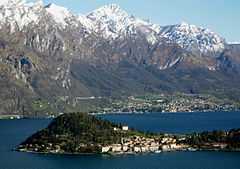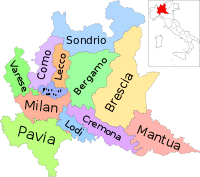Lombardy
| Lombardy Lombardia | |||
|---|---|---|---|
| Region of Italy | |||
| |||
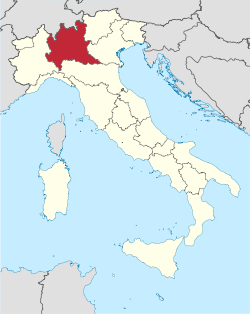 | |||
| Country | Italy | ||
| Capital | Milan | ||
| Government | |||
| • President | Roberto Maroni (Lega Nord) | ||
| Area | |||
| • Total | 23,844 km2 (9,206 sq mi) | ||
| Population (30-11-2014)[1] | |||
| • Total | 10,001,496 | ||
| • Density | 420/km2 (1,100/sq mi) | ||
| Time zone | CET (UTC+1) | ||
| • Summer (DST) | CEST (UTC+2) | ||
| GDP/ Nominal | €337.161 [2] billion (2011) | ||
| GDP per capita | €34,000[3] (2011) | ||
| NUTS Region | ITC | ||
| Website | www.regione.lombardia.it | ||
Lombardy (Italian: Lombardia Italian pronunciation: [lombarˈdiːa], Lombard: Lombardia Lombard pronunciation: (MI) [lumbar'diːa], (BG) [lombar'deːa]) is a historic region of Italy and one of the 20 regions of Italy. The capital is Milan. A sixth of Italy's population lives in Lombardy and about a fifth of Italy's GDP is produced in the region, making it the most populous and richest region in the country.[4] It is also the region with the most Unesco World Heritage Sites in Italy.[5]
Etymology
The word Lombardy comes from Lombard, which in turn is derived from Late Latin Longobardus, Langobardus (“a Lombard”), derived from the Proto-Germanic elements *langaz + *bardaz; equivalent to long beard. Some sources derive the second element instead from Proto-Germanic *bardǭ, *barduz (“axe”), related to German Barte (“axe”).[6]
Lombardy originally referred to the entire territory of Italy (known as Longobardia Major and Langobardia Minor) ruled by the Lombards, a Germanic tribe who conquered much of the Italian peninsula beginning in the 6th century.
Geography
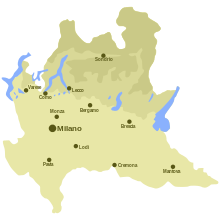
Lombardy is bordered by Switzerland (north: Canton Ticino and Canton Graubünden) and by the Italian regions of Trentino-Alto Adige/Südtirol and Veneto (east), Emilia-Romagna (south), and Piedmont (west). Three distinct natural zones can be fairly easily distinguished in the Lombardy region: mountains, hills and plains – the latter being divided in Alta (high plains) and Bassa (low plains).
The most important mountainous area is an Alpine zone including the Lepontine and Rhaetian Alps, (Piz Bernina – La Spedla, 4,020 m), the Bergamo Alps, the Ortler Alps and the Adamello massif; it is followed by an Alpine foothills zone Prealpi, which include the main peaks are the Grigna Group (2,410 m), Resegone (1,875 m) and Presolana (2,521 m).
The great Lombard lakes, all of glacial origin, lie in this zone. From west to east these are Lake Maggiore, Lake Lugano (both shared with Switzerland), Lake Como, Lake Iseo, Lake Idro, then Lake Garda, the largest in Italy. South of the Alps lie the hills characterized by a succession of low heights of morainic origin, formed during the last Ice Age and small barely fertile plateaux, with typical heaths and conifer woods. A minor mountainous area lies south of the Po, in the Apennines range.
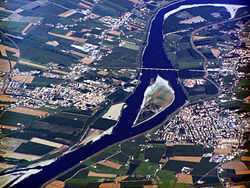
The plains of Lombardy, formed from alluvial deposits, can be divided into the Alta – an upper, permeable ground zone in the north and a lower zone characterized – the Bassa – by the so-called line of fontanili (the spring waters rising on impermeable ground). Anomalous compared with the three distinctions already made is the small region of the Oltrepò Pavese, formed by the Apennine foothills beyond the Po River.
A large number of rivers, all direct or indirect tributaries of the Po, cross the plains of Lombardy. Major rivers, flowing NW to SE, are the Ticino, the outlet of Lake Maggiore, the Olona, the Lambro, the Adda, outlet of Lake Como, the Mincio, outlet of Lake Garda, and the Oglio, the Lake Iseo outflow.
There is a wide network of canals for irrigation purposes. In the plains, intensively cultivated for centuries, little of the original environment remains. The rare elm, alder, sycamore, poplar, willow and hornbeam woods and heaths are covered now by several protected areas. In the area of the great Alpine foothills lakes, however, grow olive trees, cypresses and larches, as well as varieties of subtropical flora such as magnolias, azaleas, acacias, etc.
The mountains area is characterized by the typical vegetation of the whole range of the Italian Alps. At a lower levels (up to approximately 1,100 m) oak woods or broadleafed trees grow; on the mountain slopes (up to 2,000–2,200 m) beech trees grow at the lowest limits, with conifer woods higher up. Shrubs such as rhododendron, dwarf pine and juniper are native to the summital zone (beyond 2,200 m).
Lombardy counts many protected areas: the most important are the Stelvio National Park (the largest Italian natural park), with typically alpine wildlife: red deer, roe deer, ibex, chamois, foxes, ermine and also golden eagles; and the Ticino Valley Natural Park, instituted in 1974 on the Lombard side of the Ticino River to protect and conserve one of the last major examples of fluvial forest in Northern Italy.
Climate
The climate of this region is continental, though with variations depending on altitude or the presence of inland waters. The continental nature of the climate is more accentuated on the plains, with high annual temperature changes (at Milan an average January temperature is 1.5 °C (35 °F) and 24 °C (75 °F) in July), and thick fog between October and February. The Alpine foothills lakes exercise a mitigating influence, permitting the cultivation of typically Mediterranean produce (olives, citrus fruit).
In the Alpine zone, the valley floor is relatively mild in contrast with the colder higher areas (Bormio, 1,225 metres (4,019 feet), −1.4 °C (29 °F) average in January, 17.3 °C (63 °F) in July).
Precipitation is more frequent in the Prealpine zone (up to 1,500 to 2,000 mm (59.1 to 78.7 in) annually) than on the plains and Alpine zones (600 to 850 mm (23.6 to 33.5 in) annually). The numerous species of endemic flora (the Lombard native species), typical mainly of the Lake Como area, include some kinds of saxifrage, the Lombard garlic, groundsels bellflowers and the cottony bellflowers.
History
Prehistory and antiquity
.jpg)
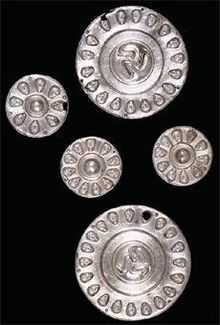
retrieved in Lombardy[7]
The area of current Lombardy was settled at least since the 2nd millennium BC, as shown by the archaeological findings of ceramics, arrows, axes and carved stones. Well-preserved rock drawings left by ancient Camuni in the Valcamonica depicting animals, people and symbols were made over a time period of eight thousand years preceding the Iron Age.[8] and 300,000.[9]
The many artifacts (pottery, personal items and weapons) found in necropolis near the Lake Maggiore, and Lake Ticino demonstrate the presence of the Golasecca Bronze Age culture that prospered in Western Lombardy between the 9th and the 4th century BC.
In the following centuries it was inhabited by different peoples among whom the Etruscans, who founded the city of Mantua and spread the use of writing; later, starting from the 5th century BC, the area was invaded by Celtic – Gallic tribes. These people settled in several cities (including Milan) and extended their rule to the Adriatic Sea.
Their development was halted by the Roman expansion in the Po Valley from the 3rd century BC onwards. After centuries of struggle, in 194 BC the entire area of what is now Lombardy became a Roman province with the name of Gallia Cisalpina ("Gaul on the inner side (with respect to Rome) of the Alps").
The Roman culture and language overwhelmed the former civilization in the following years, and Lombardy became one of the most developed and rich areas of Italy with the construction of a wide array of roads and the development of agriculture and trade. Important figures like Pliny the Elder (in Como) and Virgil (in Mantua) were born here. In late antiquity the strategic role of Lombardy was emphasized by the temporary moving of the capital of the Western Empire to Mediolanum (Milan). Here, in 313 AD, Roman Emperor Constantine issued the famous Edict of Milan that gave freedom of confession to all religions within the Roman Empire.
Middle Ages
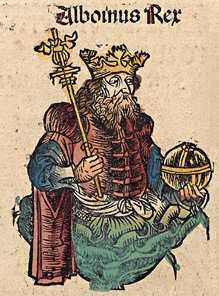
During and after the fall of the Western Empire, Lombardy suffered heavily from destruction brought about by a series of invasions by tribal peoples. The last and most effective was that of the Germanic Lombards, or Longobardi, who came around the 570s and whose long-lasting reign (with its capital in Pavia) gave the current name to the region. There was a close relationship between the Frankish, Bavarian and Lombard nobility for many centuries.
After the initial struggles, relationships between the Lombard people and the Latin-speaking people improved. In the end, the Lombard language and culture assimilated with the Latin culture, leaving evidence in many names, the legal code and laws, and other things. The end of Lombard rule came in 774, when the Frankish king Charlemagne conquered Pavia and annexed the Kingdom of Italy (mostly northern and central Italy) to his empire. The former Lombard dukes and nobles were replaced by other German vassals, prince-bishops or marquises.
The 11th century marked a significant boom in the region's economy, due to improved trading and, mostly, agricultural conditions. In a similar way to other areas of Italy, this led to a growing self-acknowledgement of the cities, whose increasing richness made them able to defy the traditional feudal supreme power, represented by the German emperors and their local legates. This process reached its apex in the 12th and 13th centuries, when different Lombard Leagues formed by allied cities of Lombardy, usually led by Milan, managed to defeat the Hohenstaufen Emperor Frederick I, at Legnano, and his grandson Frederick II, at Parma.

This did not prevent other important Lombard centres, like Cremona (then rivalling Milan for size and wealth) and others, from supporting the imperial power if this could grant them an immediate advantage. Taking advantage of the flourishing agriculture, the area around the Po River, together with Venice and Tuscany, continued to expand its industry and commerce until it became the economic centre of the whole of Europe.
The enterprising class of the communes extended its trade and banking activities well into northern Europe: "Lombard" designated the merchant or banker coming from northern Italy (see, for instance, Lombard Street in London). The name "Lombardy" came to designate the whole of Northern Italy until the 15th century and sometimes later. From the 14th century onwards, the instability created by the unceasing internal and external struggles ended in the creation of noble seignories, the most significant of which were those of the Viscontis (later Sforzas) in Milan and of the Gonzagas in Mantua.
In the 15th century the Duchy of Milan was a major political, economical and military force at the European level. Milan and Mantua became two centres of the Renaissance whose culture, with men such as Leonardo da Vinci and Mantegna, and works of art were highly regarded (for example, Leonardo da Vinci's The Last Supper). This richness, however, attracted the now more organized armies of national powers such as France and Austria, which waged a lengthy battle for Lombardy in the late 15th-early 16th century.
Modern era

After the decisive Battle of Pavia, the Duchy of Milan became a possession of the Habsburgs of Spain: the new rulers did little to improve the economy of Lombardy, instead imposing a growing series of taxes needed to support their unending series of European wars. The eastern part of modern Lombardy, with cities like Bergamo and Brescia, was under the Republic of Venice, which had begun to extend its influence in the area from the 14th century onwards (see also Italian Wars). Between the mid of the 15th century and the battle of Marignano, the northern part of east Lombardy from Airolo to Chiasso (modern Ticino), and the Valtellina valley came under possession of the old Swiss Confederacy.
Pestilences (like that of 1628/1630,[10] described by Alessandro Manzoni in his I Promessi Sposi) and the generally declining conditions of Italy's economy in the 17th and 18th centuries halted the further development of Lombardy. In 1706 the Austrians came to power and introduced some economic and social measures which granted a certain recovery.
Austrian rule was interrupted in the late 18th century by the French armies; under Napoleon, Lombardy became the center of the Cisalpine Republic and of the Kingdom of Italy, both being puppet states of France's First Empire, having as capital Milano and as head of state Napoleon. During this period Lombardy got Valtellina back from Switzerland.
The restoration of Austrian rule in 1815, as the Kingdom of Lombardy–Venetia, was characterized by the struggle with the new ideals introduced by the Napoleonic era. Lombardy became one of the intellectual centres leading the Italian unification process.
The popular republic established by the 1848 revolution was short-lived, its suppression leading to renewed Austrian rule. This came to a decisive end when Lombardy was annexed to the Kingdom of Italy 1859 as a result of the Second Italian Independence War. When annexed to the Kingdom of Italy in 1859 Lombardy achieved its present-day territorial shape by adding the Oltrepò Pavese (formerly the southern part of Novara's Province) to the province of Pavia. Starting from the late 19th century, and especially with the economic boom of the 1950s-1960s, Lombardy sharpened its status of richest and most industrialized region of Italy.
Demographics
| Historical population | ||
|---|---|---|
| Year | Pop. | ±% |
| 1861 | 3,160,000 | — |
| 1871 | 3,529,000 | +11.7% |
| 1881 | 3,730,000 | +5.7% |
| 1901 | 4,314,000 | +15.7% |
| 1911 | 4,889,000 | +13.3% |
| 1921 | 5,186,000 | +6.1% |
| 1931 | 5,596,000 | +7.9% |
| 1936 | 5,836,000 | +4.3% |
| 1951 | 6,566,000 | +12.5% |
| 1961 | 7,406,000 | +12.8% |
| 1971 | 8,543,000 | +15.4% |
| 1981 | 8,892,000 | +4.1% |
| 1991 | 8,856,000 | −0.4% |
| 2001 | 9,033,000 | +2.0% |
| 2011 | 9,704,151 | +7.4% |
| 2013 (est.) | 9,871,287 | +1.7% |
| Source: ISTAT 2011 | ||
One sixth of the Italian population or about 10 million people live in Lombardy (16.2% of the national population; 2% of the European Union population), making it the second most densely populated region in Italy after Campania with a strong concentration in the Milan metropolitan area and the Alpine foothills areas of the provinces of Varese, Como, Lecco, Monza and Brianza and Bergamo, (1,200 inh./km2), a lower average density (250 inh./km2) in the Po valley and the lower Brescia valleys, and much lower densities (less than 60 inh./km2) in the northern mountain areas and the southern Oltrepò Pavese subregion.
The growth of the regional population was particularly sustained during the 1950s–60s, thanks to a prolonged economic boom, high birth rates, and strong immigration flows (especially from Southern Italy). During the last two decades, Lombardy became the destination of a large number of international immigrants, insomuch that today more than a quarter of all foreign immigrants in Italy lives in this region. As of 2008, the Italian national institute of statistics ISTAT estimated that 815,335 foreign-born immigrants live in Lombardy, equal to 8.4% of the total regional population.
The primary religion is Catholicism; significant religious minorities include Christian Waldenses, Protestants and Orthodox, as well as Jews, Sikh and Muslims.
Economy
The gross domestic product in Lombardia (equal to over €318.424 billion in 2009) accounts for 20% of the total gross domestic product of Italy. When this measure is considered by inhabitant, it results in a value of €31,600 per inhabitant, which is almost 25% higher than the national average of €24,300.[12]
Lombardy's development has been marked by the growth of the services sector since the 1980s, and in particular by the growth of innovative activities in the sector of services to enterprises and in credit and financial services. At the same time, the strong industrial vocation of the region has not suffered. Lombardy remains, in fact, the main industrial area of the country. The presence, and development, of a very high number of enterprises belonging to the services sector represents a favourable situation for the improvement of the efficiency of the productive process, as well as for the growth of the regional economy. Lombardy is one of the Four Motors for Europe.
The region can broadly be divided into three areas as regards the productive activity. Milan, where the services sector makes up for 65.3% of the employment; a group of provinces, Varese, Como, Lecco, Bergamo and Brescia, highly industrialised, although in the two latter ones, in the plains, there is also a rich agricultural sector. Finally, in the provinces of Sondrio, Pavia, Cremona, Mantova and Lodi, there is a consistent agricultural activity, and at the same time an above average development of the services sector.
The productivity of agriculture is enhanced by a well-developed use of fertilizers and the traditional abundance of water, boosted since the Middle Ages by the construction (partly designed by Leonardo da Vinci) of a wide net of irrigation systems. Lower plains are characterized by fodder crops, which are mowed up to eight times a year, cereals (rice, wheat and maize) and sugarbeet. Productions of the higher plains include cereals, vegetables, fruit trees and mulberries. The higher areas, up to the Prealps and Alps sectors of the north, produce fruit and vines. Cattle (with the highest density in Italy), pigs and sheep are raised.
Government and politics
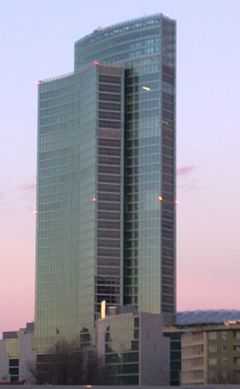
The politics of Lombardy take place in a framework of a presidential representative democracy, whereby the President of the Region (Presidente della Regione) is the head of government, and of a pluriform multi-party system. Executive power is exercised by the Regional Government (Giunta Regionale). Legislative power is vested in the 80 members Regional Council (Consiglio Regionale).
Historically, the Christian Democrats maintained a large majority of the popular support and the control of the most important cities and provinces from the end of the Second World War to the early 1990s. The opposition Italian Communist Party was a considerable presence only in southern Lombardy and in the working class districts of Milan; their base however was increasingly eroded by the rival Italian Socialist Party, until eventually the Mani Pulite corruption scandal (which spread from Milan to the whole of Italy) wiped away the old political class and parties almost entirely.
This, together with the general disaffection towards the central government (considered as wasting resources to balance the budgets of the chronically underdeveloped regions of Southern Italy), led to the sudden growth of the secessionist Northern League, particularly strong in mountain and rural areas. In the last twenty years, Lombardy stayed as a conservative stronghold, overwhelmingly voting for Silvio Berlusconi in all the six last general elections. Notwithstanding, the capital city of Milan landslide elected a new progressive mayor at the 2011 municipal elections and the 2013 regional elections saw a narrow victory for the center-right coalition.
Administrative divisions
Lombardy is divided into 12 provinces:

| Province |
Area (km²) |
Population |
Density (inh./km²) |
|---|---|---|---|
| Province of Bergamo | 2,723 | 1,096,972 | 402.8 |
| Province of Brescia | 4,784 | 1,250,817 | 261.5 |
| Province of Como | 1,288 | 594,973 | 461.9 |
| Province of Cremona | 1,772 | 362,098 | 204.3 |
| Province of Lecco | 816 | 339,752 | 416.4 |
| Province of Lodi | 782 | 226,586 | 289.7 |
| Province of Mantua | 2,339 | 411,911 | 176.1 |
| Province of Milan | 1,575 | 3,128,232 | 1,986.2 |
| Province of Monza and Brianza | 405 | 856,936 | 2,115.9 |
| Province of Pavia | 2,965 | 542,579 | 183.0 |
| Province of Sondrio | 3,212 | 181,490 | 56.5 |
| Province of Varese | 1,199 | 878,941 | 733.1 |
Cultural
Although Lombardy is often identified as merely an economic and industrial powerhouse, it has a rich and diverse cultural heritage. The many examples range from prehistory to the present day, through the Roman period and the Renaissance and can be found both in museums and churches that enrich cities and towns around the region. Major tourist destinations in the region include (in order of arrivals as of 2011)[13] the historic, cultural and artistic cities of Milan (4,246,265 arrivals), Bergamo (239,022), Como (213,996), Brescia (195,375), Varese (118,686), Monza (82,038), Mantua (81,426) and the lakes of Garda (393,601), Como (357,223), Iseo (127,410) and Maggiore (66,819).
UNESCO World Heritage Sites
- Church and Dominican Convent of Santa Maria delle Grazie with "The Last Supper" by Leonardo da Vinci
- Crespi d'Adda
- Rock Drawings in Valcamonica
- Sacri Monti of Piedmont and Lombardy
- The castrum with the Torba Tower and the church outside the walls, Santa Maria foris portas, in Castelseprio
- Mantua and Sabbioneta
- The monumental archaeological area of the Roman forum and the monastery complex of San Salvatore-Santa Giulia in Brescia
- Monte San Giorgio
- Bernina Railway
- Prehistoric pile dwellings around the Alps
Museums
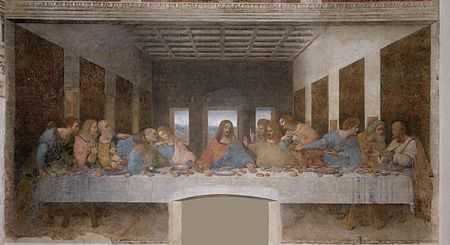
Lombardy contains numerous museums (over 330) of different types: ethnographic, historical, technical-scientific, artistic and naturalistic which testify to the historical-cultural and artistic development of the region. Among the most famous are the National Museum of Science and Technology "Leonardo da Vinci" (Milan), the The Last Supper of Leonardo da Vinci (Milan), the Accademia Carrara (Bergamo), the Museum of Santa Giulia (Brescia), the Volta Temple (Como), the Stradivari Museum (Cremona), the Palazzo Te (Mantua), the Museum Sacred Art of the Nativity and the basilica of Santa Maria Assunta at Gandino, the Royal Villa of Monza and many others.
Main sights
- Cathedral of Milan
- Castello Sforzesco
- Basilica di Sant'Ambrogio
- Convent of Sta. Maria delle Grazie
- The Last Supper
- Teatro alla Scala
- Basilica of San Lorenzo
- Basilica of Sant'Eustorgio
- Portinari Chapel
- Brera Gallery
- Petroglyphs of Valcamonica
- Certosa di Pavia
- Bellagio
- Lake of Como
- Lake of Garda
- Industrial village of Crespi d'Adda
- Duomo and Torrazzo in Cremona
- Royal Villa of Monza
- Tempio Civico della Beata Vergine Incoronata in Lodi
- Palazzo Te, Castello di San Giorgio, Basilica di Sant'Andrea and Cathedral in Mantua
Cuisine
Rice is popular in the region, often found in soups as well as risotti, such as "risotto alla Milanese", with saffron. In the city of Monza a popular recipe also adds pieces of sausages to the risotto. Regional cheeses include robiola, crescenza, taleggio, gorgonzola and grana padano (the plains of central and southern Lombardy allow intensive cattle-raising). Butter and cream are used. Single pot dishes, which take less work to prepare, are popular. In Bergamo, Brescia, and Valtellina, polenta is common. In Valtellina, Pizzoccheri is common, also. In Mantua, festivals feature tortelli di zucca (ravioli with pumpkin filling) accompanied by melted butter and followed by turkey stuffed with chicken or other stewed meats.[14]
Typical dishes
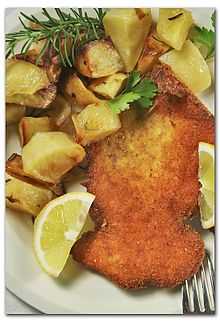
- Polenta (Asino e Polenta, Polenta e Osei, Vunscia Polenta, Polenta e Gorgonzola)
- Pizzoccheri (tagliatelle of buckwheat and wheat, laced with butter, green vegetables, garlic, sage, potatoes and onions, topped with Casera cheese)
- Quartirolo lombardo
- Risotto alla Milanese
- Osso buco
- Cotoletta (Cutlet) alla Milanese
- Cassoeula
- Gorgonzola cheese
- Bitto cheese
- Grana Padano cheese
- Panettone
- Lo Spiedo Bresciano – spit roast of different cuts of meat with butter and sage
- Tortelli di Zucca (Pumpkin-filled pasta)
- Sbrisolona cake
Wines
- Franciacorta
- Nebbiolo red
- Bellavista
- Santi
- Nino Negri
- Bonarda Lombardy
- Inferno (Valtellina)
- Grumello (Valtellina)
- Sassella (Valtellina)
Music
.jpg)
Besides Milan, the region of Lombardy has 11 other provinces, most of them with equally great musical traditions. Bergamo is famous for being the birthplace of Gaetano Donizetti and home of the Teatro Donizetti; Brescia is hosts the impressive 1709 Teatro Grande; Cremona is regarded as the birthplace of the commonly used violin, and is home to several of the most prestigious luthiers in the world, and Mantua was one of the founding and most important cities in 16th and 17th opera and classical music.
Other cities such as Lecco, Lodi, Varese and Pavia also have rich musical traditions, but Milan is the hub and centre of the Lombard musical scene. It was the workplace of Giuseppe Verdi, one of the most famous and influential opera composers of the 19th century, and boasts a variety of acclaimed theatres, such as the Piccolo Teatro and the Teatro Arcimboldi; however, the most famous is the 1778 Teatro alla Scala, one of the most important and prestigious operahouses in the world.
Language
Apart from standardized Italian, Lombard is the local language of Lombardy. Lombard is a member of the Gallo-Italic group within the Romance languages. It is spoken natively in Northern Italy (most of Lombardy and some areas of neighbouring regions, notably the eastern side of Piedmont) and Southern Switzerland (Ticino and Graubünden).
The two main varieties (Western Lombard language and Eastern Lombard language) show differences and are often, but not always, mutually comprehensible. The union of Western Lombard or Insubric, Eastern Lombard and intermediate varieties under the denomination of "Lombard" is a matter of debate, and it has been argued that the two might potentially form separate languages.[15]
Fashion
Lombardy has always been an important centre for silk and textile production, notably the cities of Pavia, Vigevano and Cremona, but Milan is the region's most important centre for clothing and high fashion. In 2009, Milan was regarded as the world fashion capital, even surpassing New York, Paris, Rome and London.[16] Most of the major Italian fashion brands, such as Valentino, Versace, Prada, Armani and Dolce & Gabbana (to name a few), are currently headquartered in the city.
References
- ↑ "Monthly demographic balance, January-June 2013". [Istat]. Retrieved 30 November 2013.
- ↑ "Eurostat – Tables, Graphs and Maps Interface (TGM) table". Epp.eurostat.ec.europa.eu. 12 August 2011. Retrieved 16 September 2011.
- ↑ "European Commission - PRESS RELEASES - Press release - Regional GDP per inhabitant in 2008 GDP per inhabitant ranged from 28% of the EU27 average in Severozapaden in Bulgaria to 343% in Inner London". europa.eu.
- ↑ "EUROPA – Press Releases – Regional GDP per inhabitant in the EU27, GDP per inhabitant in 2006 ranged from 25% of the EU27 average in Nord-Est in Romania to 336% in Inner London". Europa (web portal). 19 February 2009. Retrieved 10 May 2010.
- ↑ ITALY: WORLD HERITAGE SITES Regione Lombardia
- ↑ Partridge, Eric (2009). Origins : an etymological dictionary of modern English ([Paperback ed.] ed.). London: Routledge. ISBN 0415474337.
- ↑ "Museo del monastero di Santa Giulia in Brescia". Santagiulia.info. Retrieved 16 September 2011.
- ↑ Piero Adorno, Mesolitico e Neolitico, p. 16.
- ↑ "Introduzione all'arte rupestre della Valcamonica su Archeocamuni.it" (in Italian). Retrieved 11 May 2009.
- ↑ From an italian website a brief history of the pestilence
- ↑ OECD. "Competitive Cities in the Global Economy" (PDF). Retrieved 30 April 2009.
- ↑
- ↑ "RSY Lombardia-Arrivals and nights spent by guests in accommodation establishments, by type of resort and by type of establishment. Other accommodation establishments. Part III. Tourist resort. Year 2011". asr-lombardia.it. Retrieved 27 November 2013.
- ↑ Piras, 87.
- ↑ "Ethnologue report for language code:lmo". Ethnologue.com. Retrieved 16 September 2011.
- ↑ "The Global Language Monitor » Fashion". Languagemonitor.com. 20 July 2009. Retrieved 3 January 2010.
External links
![]() Media related to Lombardy at Wikimedia Commons
Media related to Lombardy at Wikimedia Commons
| ||||||||||
| ||||||||||||||||||||||||||||||||||||||||||||


